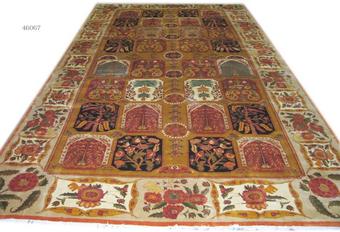New handmade oversize rug No. 46067 Bakhtiari Iran 655 x 417 cm

Larger images (will open in new window)
Please click on the thumbnails below for a larger view
| main view |
 |
| Item Number: |
46067 |
| Name: |
Bakhtiari |
| Country of Origin: |
Iran |
| Size: |
655 x 417 cm |
| Age:
|
new |
| Pile: |
wool |
Foundation
(warp and weft): |
cotton |
| Design: |
floral / allover |
| Ground Color: |
multi coloured |
| Remarks: |
This is a unique handmade / hand-knotted / traditional oriental carpet
The pile of this carpet is made of wool
This piece has been dyed with vegetable dyes only. |
 add to cart
add to cart
More about the provenance Bakhtiari | Iran
The name originates from the times when the landlords of the area were Bakhtiaris. Today Bakhtiari rugs are mainly made by peasants, therefore Bakhtiaris are not nomadic rugs as often mistakenly assumed. Bakhtiari rugs are of high uniqueness and durability.
This is an Oriental nomadic rug. The word "nomad" comes from the Greek word "nemein". Nomads are wandering tribes, shepherds, stockbreeders, or hunters. In the minorly populated areas of Asia and North Africa they move with their herds, all their belongings and their tents to new places constantly. Many states already tried to make them settle down with various success. Mostly it is the women of the tribes which contribute to the family's income with their carpet knotting and weaving while the men breed stock or go hunting. But due to the circumstances of nomadic life the carpet production often lacks regularity and precision in form and design, which actually adds to their originality and makes them even more popular. The wool is mostly dyed with vegetable dyes.
This Oriental carpet has a so called "garden design" or as in Persian "Kheshti". The design of Oriental "garden rugs" represents sophisticated garden layouts from a bird's eye view. The oldest garden rugs date back to the 16th century. The legendary rug "Spring of Khosrow" of Khosrow the Sassanide king served as a template. The rugs are divided into fields which are separated by water ditches. The ditches in which often fish and ducks are swimming are flanked by bushes and flowers. Altogether garden rugs are an expression of the special Oriental love of floral beauty which peaked in fantastically laid out gardens.
The wool of this rug has been dyed with vegetable dyes only which became very rare in Oriental rugs. Since ca. 1850 synthetic dyes found their way into carpet production. Ever since they replaced natural vegetable dyes more and more also due to the fact that the production of vegetable dyes is very time consuming and difficult. But the "aura of genuineness" can be reached to its full extent with vegetable dyes only. Vegetable dyes are made from leaves, flowers, branches, fruits and roots. They give Oriental rugs a particularly harmonic look. In general Oriental rugs "age" better and more beautifully with vegetable dyes than with synthetic dyes plus they increase a carpet's value. Most of today's production is made with synthetic dyes which makes this rug an even more desirable piece. Unfortunately many rugs in the market are being labelled as being vegetable dyed which in many colors is simply not true which damages the reputation of the carpet industry altogether.

